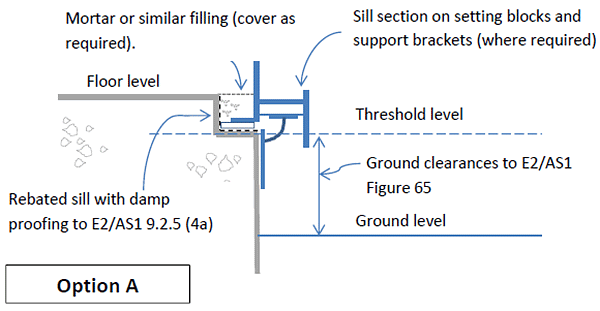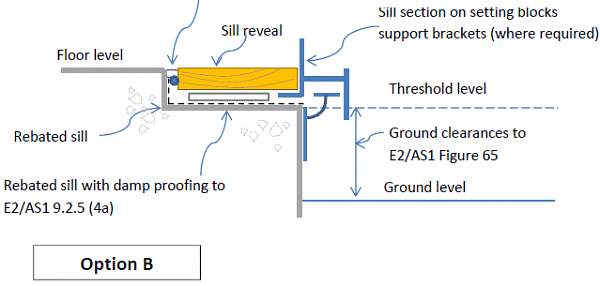Understanding door thresholds in E2/AS1
This guidance looks at whether rebated door sills comply with E2/AS1.
The information was confirmed as current in November 2017. It originally appeared in Codewords 61.
E2/AS1 includes general door sill details (Figures 17C and 17D), and specific door sill details for masonry veneer (Figure 73D). These all show sills positioned at floor level (ie not rebated).
Floor levels versus threshold levels
Figure 14 (Threshold levels – relative to decks) addresses threshold levels rather than floor levels as being critical for weathertightness. Although Figure 14 refers to decks, the principal applies equally to general door thresholds. It acknowledges that floor levels could be the same as threshold levels, or they could be above or below a threshold level.
This is most obvious with the use of ‘step-over’ bulkheads at doors to decks. It is the bulkhead threshold level that is important, not the internal floor level.
Similarly a floor level could be above a threshold level. In Figures 17C, 17D and Figure 73D, the details are equally applicable if the floor level beyond the sill reveal stepped up. In other words, a rebated sill – please refer to Options A and B below.
Ground clearances
Figure 65 of E2/AS1 shows minimum floor clearance requirements above external ground. These clearances provide protection to building elements, including cladding, wall framing, and especially bottom plates. Where a rebated sill is used, these clearance dimensions apply to the threshold level of the rebate. In other words, if the rebate is 30 mm below floor level, the relevant ground to floor level dimensions in Figure 65 are increased by 30 mm.
Figure 65 of E2/AS1 – option A

Apply sealant as air seal on backing rod between reveal and rebate upstand.
Figure 65 of E2/AS1 – option B

Notes:
To all rebated sills, apply damp proofing to concrete rebate and upstands. Refer E2/AS1 9.2.5 (4a) for damp proofing options.
Rebated sills in direct fixed claddings do not require a separate sill flashing as shown for non-rebated installations in E2/AS1 Figure 17D (a).